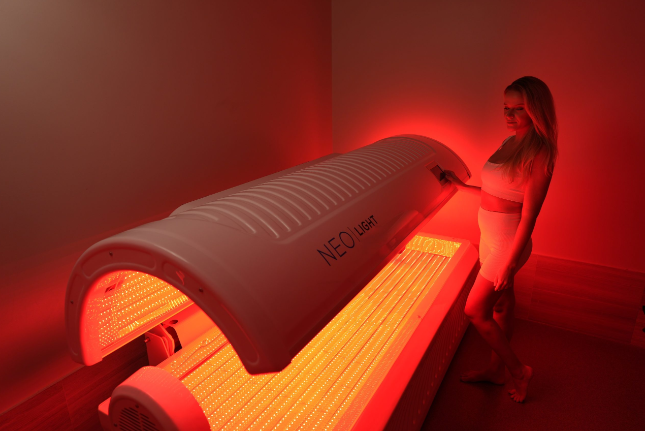Your body is made of 206 bones, over 600 muscles, dozens of organs, and trillions of cells.
It can convert almost any sort of food into useable energy, fight off many diseases, and, with exercise and a healthy diet is capable of astounding physical and mental feats.
However, like even the most well-designed machine, the human body can also go wrong. Many health issues are linked directly to the processes of aging, whereas others are the fault of lifestyle and others are genetic.
Modern medicine has made great leaps forward regarding the treatment of common illnesses and diseases, and we all know how important diet and exercise are for long-term health. However, there may be another way to enhance health and fight off some illnesses and diseases–something as simple as shining a special light on the affected part of your body.
Sounds interesting, right?
That something is red light therapy.
What is Red Light Therapy?
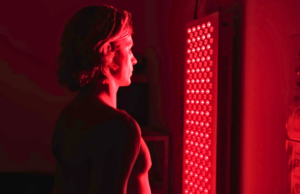
Red light therapy might sound like science fiction, but it’s actually science fact. Used initially by NASA to help plants grow in space, red light therapy uses wavelengths of light to enhance the body’s natural ability to heal itself. Red light therapy has been in use for over 50 years, but, until recently, was considered a fringe treatment that was not widely recognized by the medical community.
However, red light therapy, also known as low-level laser therapy (LLLT) or photobiomodulation, is becoming more accepted and research supports its efficacy for treating a host of conditions.
Red light therapy is non-invasive, painless, and natural. The frequency of light used in red light therapy is also present in sunlight.
How Does Red Light Therapy Work?
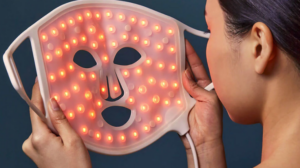
Red light therapy involves placing a special light source, usually a light-emitting diode or LED lamp, next to the skin. The light penetrates the skin to a depth of around 8-12 mm or one-third to half an inch. Once absorbed, the light is converted into cellular energy and triggers a host of metabolic events including:
Increased nitric oxide production, which dilates blood vessels and boosts circulation
-
Formation of new capillaries
-
Improved lymphatic drainage
-
Increased production of fibroblasts–cells that produce collagen
-
Increased release of ATP, the energy currently of the human body
-
Increased phagocytosis, the process of removing dead cells
-
Tissue granulation stimulated and skin cell renewal
-
Reduced inflammation
-
Reduced muscle tension
-
Reduced stress
These different metabolic processes can be linked directly or indirectly to a host of benefits from improved skin health to reduced joint pain.
What are the Benefits of Red Light Therapy?
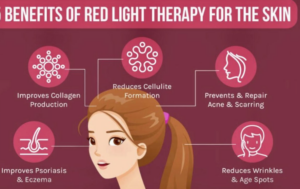
Red light therapy offers a wide range of benefits. Those benefits very much depend on where the treatment is applied. Those benefits include:
-
Improved general skin condition – skin looks brighter and smoother
-
Reduced wrinkles including frown and laughter lines
-
Reduced sun damage
-
Speeds the healing of acne, eczema, and rosacea, psoriasis,
-
Reduces redness and flushed skin – especially when brought on by allergies
-
Reduced scarring and stretch marks
-
Prevents hair loss and stimulates hair growth
-
Speeds the healing cold sores
-
Speeds the healing of cuts, bites, bruises, and grazes
-
Eases muscle pain
-
Relieves joint pain
-
Speeds up recovery from sprains and strains
-
Reduces pain of tendonitis
-
Reduces pain of carpal tunnel syndrome, golfer’s elbow, tennis elbow, and other chronic conditions
-
Helps treat fibromyalgia
-
Speeds up recovery after surgical procedures by enhancing healing
-
Speeds up repair of broken bones
-
Helps to close open wounds
-
Treatment of tinnitus
Needless to say, you should never attempt to treat serious medical conditions yourself–leave that to the professionals. However, more and more medical professionals are turning to red light therapy to treat a host of medical conditions, albeit alongside more traditional treatments.
You could, however, use red light therapy to electively treat numerous less serious conditions.
Is Red Light Therapy Supported by Science?
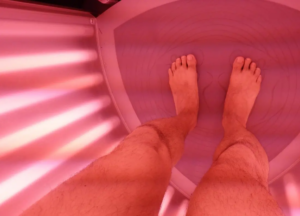
Unlike so many seemingly miraculous pseudo-medical treatments, red light therapy has been extensively studied. There is quite a lot of research supporting its use. Much of the original research was done by NASA because they were amongst the first people to discover the scientific benefits of red light therapy. However, many other studies support its use.
There are literally thousands of studies you can wade through, but some of the more interesting ones include:
1.Low-level laser therapy with a wrist splint to treat carpal tunnel syndrome: a double-blinded randomized controlled trial – https://www.ncbi.nlm.nih.gov/pubmed/24477392
This study, conducted by the Department of Physical Medicine and Rehabilitation at Navamindradhiraj University, Bangkok, Thailand, noted that patients treated with red light therapy experienced greater pain relief and improved hand function compared to those treated with a placebo and those effects lasted for several months.
2. Low-level laser therapy to treat fibromyalgia – https://www.ncbi.nlm.nih.gov/pubmed/24801056
The Physical Therapy Department at Universidade Estadual do Centro-Oeste (UNICENTRO), Guarapuava, Brazil, reported that red light therapy was found to be useful in the treatment of fibromyalgia and reduced pain and other associated symptoms.
3. Light-emitting diode phototherapy improves muscle recovery after a damaging exercise – https://link.springer.com/article/10.1007%2Fs10103-013-1486-z
A study conducted by scientists at the Department of Biological Sciences, State University of Southwest Bahia (UESB) Jequie, Brazil discovered that red light therapy could accelerate recovery after very strenuous exercise and reduce the severity and longevity of muscle soreness.
4. Regulation of skin collagen metabolism in vitro using a pulsed 660 nm LED light source: clinical correlation with a single-blinded study – https://www.ncbi.nlm.nih.gov/pubmed/19587693
RoseLab Skin Optics Laboratory, Canada, investigated the effect of red light therapy on collagen, which is an important substance for skin health and is linked to improved skin appearance. They found that treatment reduced wrinkles and improved skin elasticity after just 12 treatments.
5. A Controlled Trial to Determine the Efficacy of Red and Near-Infrared Light Treatment in Patient Satisfaction, Reduction of Fine Lines, Wrinkles, Skin Roughness, and Intradermal Collagen Density Increase – https://www.ncbi.nlm.nih.gov/pmc/articles/PMC3926176/
Scientists at Medical Light Consulting, in Heidelberg, Germany, studied the effect of red light therapy on skin health and appearance. They concluded “The application of red light therapy (RLT) and Energizing Light Technology (ELT) provides a safe, non-ablative, non-thermal, atraumatic photobiomodulation treatment of skin tissue with high patient satisfaction rates. RLT and ELT can extend the spectrum of anti-aging treatment options available to patients looking for mild and pleasant light-only skin rejuvenation.”
6. Is light-emitting diode phototherapy (LED-LLLT) really effective? – https://www.ncbi.nlm.nih.gov/pmc/articles/PMC3799034/
In this wide-ranging study by researchers at the Department of Dermatology, Kangbuk Samsung Hospital, Sungkyunkwan University School of Medicine, Seoul, Korea, and the Korean Institute for Photomedicine and Photosurgery Research, Goyang, South Korea, studied the use of red light therapy for a host of purposes from pain relief to skin rejuvenation. They concluded that providing the right equipment and correct light/wavelength was used, “LED phototherapy does indeed work and has many useful aspects in clinical practice for practitioners in many surgical specialties.”
Are there any Risks to Red Light Therapy?
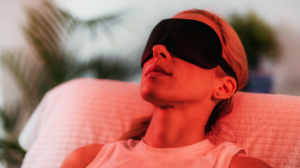
Red light is present in normal sunlight, which means red light therapy is completely natural. Red light emitting lamps simply project a beam of isolated red light that is just more concentrated than you’d normally get in sunlight. Harmful ultraviolet light is not part of red light, so there is no risk of burning or other unwanted side effects.
The only real danger of red light therapy is to the eyes – not because red light itself will damage the eyes but the devices that emit red light do so with a bright glare that could be painful. To avoid this hazard, wear protective eyewear during treatment and never shine a red light device into anyone’s eyes.
Other considerations include:
-
During Pregnancy – while no evidence has revealed any risks for red light therapy during pregnancy, none support its use either. For this reason, red light therapy is not recommended during pregnancy.
-
Cancer – red light therapy has been successfully used alongside other cancer treatments, however, should always be approved for use by the attending medical professional. It is not a substitute for medical treatment.
-
Hemorrhage – because red light therapy increases blood flow, it should not be used over the site of a hemorrhage or internal bleeding. If you are on a blood thinning agent or anticoagulant, consult your doctor before using red light therapy.
-
Epilepsy – red light therapy uses flashing LEDs which could increase the risk of seizure.
Red Light Therapy Reviews
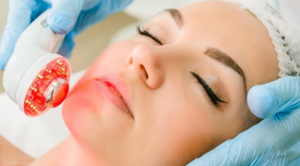
Red light therapy comes in all shapes and sizes, and reviews often focus on one particular product rather than the therapy itself. However, here are a few of the things that people are saying about red light therapy.
Review 1
Firenze, on realself.com, says, “I have been using led light in all its frequencies for well over 10 years and I think it should be part of every woman’s beauty routine. Personally, I use the Qasr MD which is the professional model which has red light, flashing Amber or red and ultraviolet. I use it once a week or sometimes twice on my face, hands and décolleté. It gives your skin a rosy, healthy complexion (stimulates blood circulation) and defiantly refines the pores. I have quite a consistent maintenance routine of lasers, dermabrasion and sculpture so cannot really assess its wrinkle fighting benefits completely. I used it for 6 months on the back of one hand and not the other and you can certainly see a BIG difference…Much smoother and LESS lines. I highly recommend anyone to add this to their maintenance routine.”
Review 2
Bigfoot, on doesitreallywork.org, says, “Don’t just think Red Light Therapy is for vain people looking to clear themselves of wrinkles and get better skin. I’ve used Red Light Therapy to help me with my acne. I tried loads of medication/creams etc. but nothing has worked up to now as well as RLT.
If you have skin problems like I do, then check it out!”Review 3
Laura, on amazon.com, says “This is my 7th week using the product. It does help minimize wrinkles. Using the light does dry your skin out a little but with really oily skin I found this to be a good thing. It also helps minimize acne scars and clear your skin up. When applying makeup, you use less because your skin is smoother and poor size is smaller, which does help with future breakouts. A little pricey but well-constructed and if you have spent any money on facials, definitely cheaper than going to the spa.”
Red light therapy—Our Take
Red light therapy is backed by scientific research and can help treat a wide range of conditions–both mild and serious. However, it’s important to understand that there is a big difference between a $50 home red light unit and a $10,000 professional medical red light unit, and results can vary enormously. Needless to say, the researchers who studied red light therapy were not using small LED arrays!
It’s clear that red light therapy can work, but the caveat is that you use good quality equipment. That might mean you need to spend quite a lot of money and commit to regular treatments.
The bottom line is you should manage your expectations. The results you experience will very much depend on the type of equipment you use. Professional quality equipment is more likely to produce the best results. Although decent home-use machines can work too–you’ll just need to use them more often and for longer.
How to Get Red Light Therapy
Red light therapy is available at dermatologists, doctor’s offices, and tanning salons. There are also home red light emitting devices available.
Professional models provide a very intense dose of red light, and you’ll probably need to commit to a course of treatments – say eight to twelve. The cost per appointment depends on how many areas of the body are treated but can range from $20-50 per session. Discounts may be available for packages booked and paid for in advance.
Home red light therapy machines cost between $50-$800+ and can be as small as one single LED to several hundred. Some devices are handheld whereas others are lamps that you sit or stand in front of. Some machines are even shaped like masks and worn over the face.

